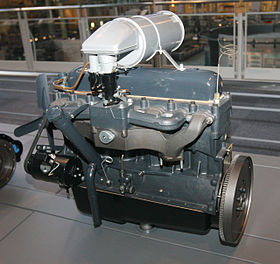Toyota Type C engine
| Type A | |
|---|---|
 |
|
| Overview | |
| Manufacturer | Toyota |
| Production | 1935–1947 |
| Combustion chamber | |
| Configuration | I6 |
| Displacement | 3,389 cc (3.4 L; 206.8 cu in) |
| Cylinder bore | 84.1 mm (3.3 in) |
| Piston stroke | 101.6 mm (4.0 in) |
| Cylinder block alloy | iron |
| Cylinder head alloy | iron |
| Valvetrain | OHV |
| Combustion | |
| Fuel system | carburettor |
| Fuel type | Gasoline |
| Output | |
| Power output | 62 PS (46 kW; 61 hp) |
| Type B | |
|---|---|
| Overview | |
| Manufacturer | Toyota |
| Production | 1937-1955 |
| Combustion chamber | |
| Configuration | I6 |
| Displacement | 3,386 cc (3.4 L; 206.6 cu in) |
| Cylinder bore | 84.1 mm (3.3 in) |
| Piston stroke | 101.6 mm (4.0 in) |
| Cylinder block alloy | iron |
| Cylinder head alloy | iron |
| Valvetrain | OHV |
| Compression ratio | 6.4:1 |
| Combustion | |
| Fuel system | carburettor |
| Fuel type | Gasoline |
| Output | |
| Power output | 62-82 HP |
| Chronology | |
| Successor | Toyota F engine |
| Type C | |
|---|---|
| Overview | |
| Manufacturer | Toyota |
| Production | 1939-1941 |
| Combustion chamber | |
| Configuration | I4 |
| Displacement | 2,259 cc (2.3 L; 137.9 cu in) |
| Cylinder bore | 84.1 mm (3.3 in) |
| Piston stroke | 101.6 mm (4.0 in) |
| Cylinder block alloy | iron |
| Cylinder head alloy | iron |
| Valvetrain | OHV |
| Compression ratio | 6.4:1 |
| Combustion | |
| Fuel system | carburettor |
| Fuel type | Gasoline |
| Output | |
| Power output | 49 PS (36 kW; 48 hp) |
| Torque output | 152 N·m (112 lb·ft) @ 1400 rpm |
| Type E | |
|---|---|
| Overview | |
| Manufacturer | Toyota |
| Production | 1938 |
| Combustion chamber | |
| Configuration | I2 two-stroke |
| Displacement | 585 cc (0.6 L; 35.7 cu in) |
| Combustion | |
| Fuel system | carburettor |
| Fuel type | Gasoline |
| Type S | |
|---|---|
 |
|
| Overview | |
| Manufacturer | Toyota |
| Production | 1947-1959 |
| Combustion chamber | |
| Configuration | I4 |
| Displacement | 995 cc (1.0 L; 60.7 cu in) |
| Cylinder bore | 65 mm (2.6 in) |
| Piston stroke | 75 mm (3.0 in) |
| Cylinder block alloy | iron |
| Cylinder head alloy | iron |
| Valvetrain | side valve |
| Compression ratio | 6.5:1 |
| Combustion | |
| Fuel system | carburettor |
| Fuel type | Gasoline |
| Output | |
| Power output | 27 PS (20 kW; 27 hp) |
| Torque output | 98 N·m (72 lb·ft) @ 2400 rpm |
| Chronology | |
| Predecessor | None |
| Successor | Toyota P engine |
The Type A engine was a straight-6 engine produced from 1935 through 1947 by Toyota.
The Type B was a technically more advanced version of the Type A.
The Type C was a straight-4 engine derived from the Type A.
Many parts were interchangeable between the Type A, Type B and Type C engines (e.g. pistons, valves, rods). Many of the same parts were also interchangeable with the Chevrolet Stovebolt engine, from which it was derived.
The Type E was a copy of a DKW engine.
The Type S was a straight-4 engine that replaced the Type A, B and C in Toyota's passenger cars.
The Type A engine was Toyota's first production engine, being produced from 1935 through 1947.
This engine was a 3,389 cc (3.4 L; 206.8 cu in) pushrod, overhead valve, 6-cylinder, three bearing engine copied from the 1929–36 Chevrolet Gen-1 3 bearing Stovebolt L6 OHV engine. By virtue of a modified intake manifold it produced 62 PS (46 kW), while the Chevrolet engine produced 60 PS (44 kW). GM used a number of local Japanese suppliers for the smaller engine parts (e.g. carburettors). Toyota was able to use the same suppliers for its cars. The parts were identical enough that pistons, rods, valves, etc. could be used in both the Chevrolet and Toyota engines interchangeably. There are several recorded instances of parts intended for one being used to repair the other.
Toyota had initially considered copying the Ford flathead V8 because it was the most popular engine in Japan at the time. However, the machining of two separate banks of cylinders would add too much to the production cost, so the Chevrolet engine was copied instead.
Other references to the Chevy engine claim different power figures. Different manufactures used different measuring techniques (e.g. with or without the generator/alternator connected), engines differed from year to year and that some manufacturers simply lied. In this case, Toyota did back to back comparisons using the same techniques, so it is likely that the Toyota engine did in fact produce slightly more power than the Chevy engine on which it was based. Also, the Chevy engine was likely to be a year or two old, so the current Chevy engine may have produced even more power.
...
Wikipedia
